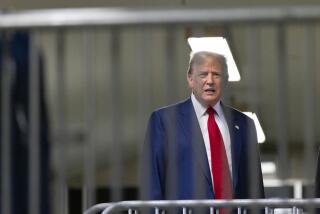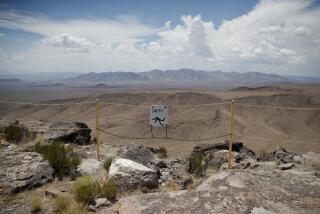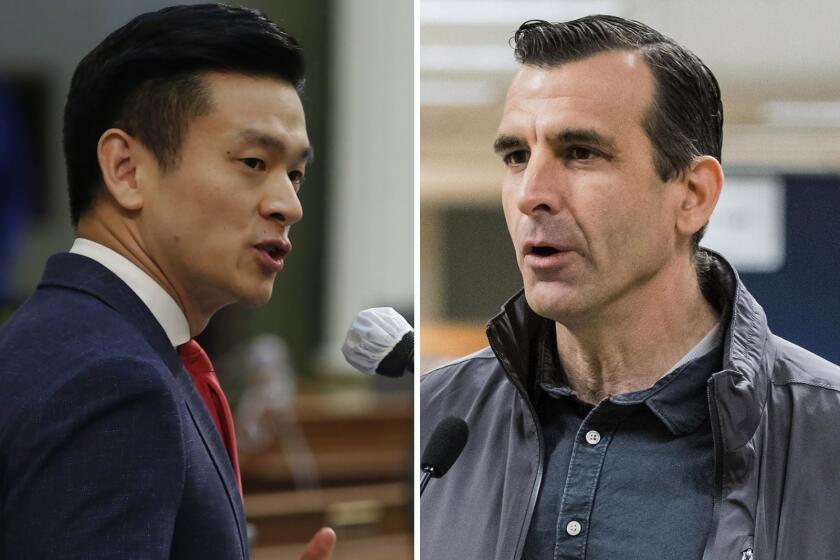Delay Would Complicate Balloting
The court decision that could delay California’s recall until March raised a host of practical questions Monday -- among them, whether a ballot that includes the recall and the presidential primary might prove too massive to process, and how counties would pay for a costly shift in timing.
Conny McCormack, the Los Angeles County registrar-recorder, said she did not think the county’s new optical-scan voting system could accommodate a ballot packed with the recall, a presidential primary, and an array of initiatives and local races.
“We would not have the capacity,” McCormack said after hearing of the federal appeals court ruling, which ordered the Oct. 7 election postponed, possibly until March 2.
Election officials suddenly had to grapple with new questions: Can they break the election into two ballots? Would they be required to reopen the recall election to more candidates? Could candidates who want to drop off the ballot be allowed to do so? What will happen to the thousands of absentee ballots that have been filled out and returned?
And how much is this latest twist in an improbable political saga going to cost California taxpayers?
Answers were hard to come by Monday, although it appeared certain that any change in the election’s timing would add millions of dollars to an already expensive undertaking. County officials said they had spent much of the money allocated for the Oct. 7 election, and would lose most of it if the election is held in March.
“It would be like taking $350,000 and throwing it in Monterey Bay,” said Gail Pellerin, elections manager in Santa Cruz County. She was referring to losses for her relatively small county alone.
Officials in San Diego, Sacramento and Orange counties said they had spent more than $1 million preparing for the recall election. McCormack did not say how much Los Angeles County stood to lose but said she had budgeted $13 million for the Oct. 7 election, and had already spent more than $6 million to print and mail sample and absentee ballots, and to hire election workers.
Secretary of State Kevin Shelley, who spent Monday in San Francisco, declined to speak to reporters about the ruling. He instructed county elections officials to continue preparing for an Oct. 7 election. His staff conferred with lawyers in the state attorney general’s office concerning the possibility of appeals, aides said.
Among the issues being considered by Shelley’s office is whether nominations for candidates would be reopened. That could add to the complexity of an unwieldy ballot as well as change the political dynamics of the race if some prominent names enter the field.
Election officials also wondered whether they should strip the ballot of candidates such as Bill Simon Jr. and Peter V. Ueberroth, who have announced that they are no longer running.
Then there is the matter of absentee ballots.
McCormack said about 30,000 Los Angeles County voters have mailed in their absentee ballots. They are “under lock and key,” not to be opened until election night -- whenever that may be. McCormack said that she would look to the court for further instruction about how to proceed.
Another concern to some election officials is whether voters will be able to make sense of a ballot that combines two complicated elections.
The March election would include a primary ballot for president; U.S. Senate and House seats; some legislative seats; local elections, including those for county board of supervisors, judgeships, city, school board and other special district positions; and ballot measures, including a public education facilities bond act and others that qualify in the interim.
Add the two-step recall election as well as ballot initiatives from the Oct. 7 ballot, and the result, election officials fear, is a recipe for mass confusion.
“People may think, ‘I already voted for that,’ and not vote on the recall, or they may not turn up at all,” said Mischelle Townsend, the registrar in Riverside County.
Of greater concern to McCormack was whether the county could hold the election at all. Los Angeles County is about to switch from its old punch-card ballot system to a new “InkaVote” system, which uses optical scanning to read ballots that voters mark with a special pen. Each ballot card can accommodate 312 tiny ovals -- the equivalent of 12 pages of questions and candidates in the laminated ballot books in its voting booths.
The last presidential primary, in 2000, took up 10 pages. The recall election would consume up to eight pages, McCormack said.
“Can the current system be modified to count two separate cards?” McCormack asked. “We’re going to look at whether that’s feasible.”
Among the options being considered, she said, are having voters cast ballots on two InkaVote machines, one for the recall and one for the primary; using one machine with multiple ballot cards; or trying to lease another voting system for temporary use.
The first two options could create lengthy delays at polling places.
Jill LaVine, the acting recorder-clerk in Sacramento County, said she faced similar hurdles. Her county is similarly switching from a punch-card to an optical scanning system.
“Impossible, no. Difficult, yes,” LaVine said. She said that if all 135 candidates remain in the gubernatorial race, she would be hard-pressed to fit all the election races and ballot measures on a single ballot card.
McCormack, whose department serves Los Angeles County’s 4 million voters, complained angrily that neither party in the lawsuit -- which primarily pitted the American Civil Liberties Union against Shelley -- consulted her to see whether consolidating the recall with the March primary was feasible.
Although she maintained that it might not be, McCormack is legally obligated to hold the election, regardless of the difficulties, said Fred Woocher, an election law specialist.
“I just think they’re going to have to figure out a way to deal with it,” he said.
*
Times staff writers Joel Rubin and Mitchell Landsberg contributed to this report.
More to Read
Get the L.A. Times Politics newsletter
Deeply reported insights into legislation, politics and policy from Sacramento, Washington and beyond. In your inbox three times per week.
You may occasionally receive promotional content from the Los Angeles Times.






